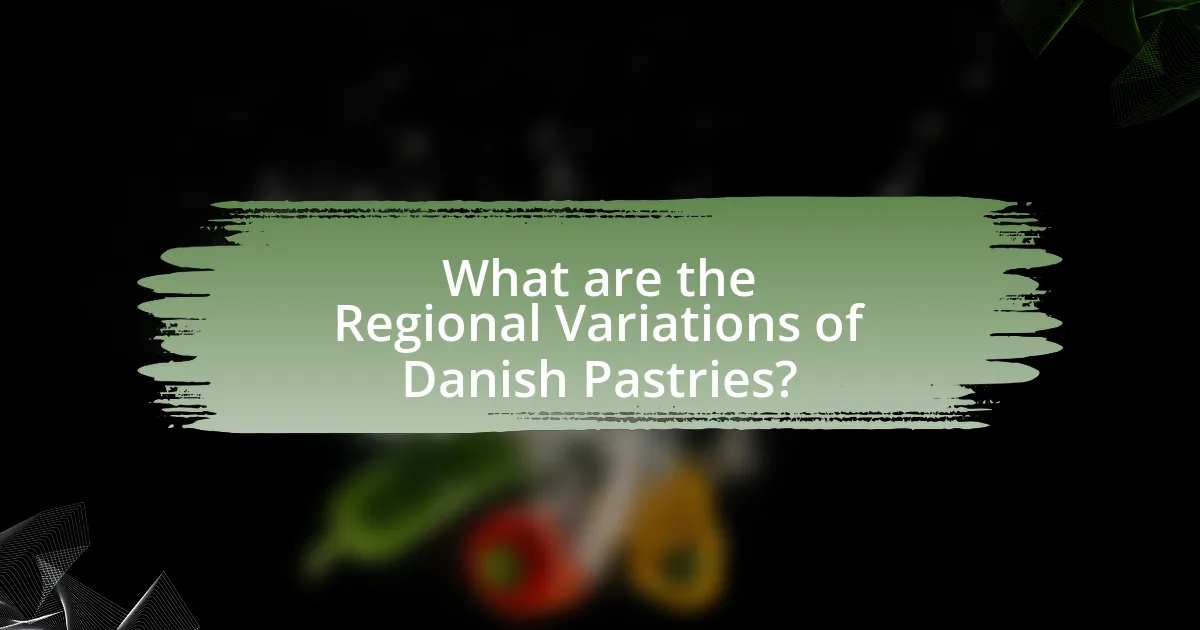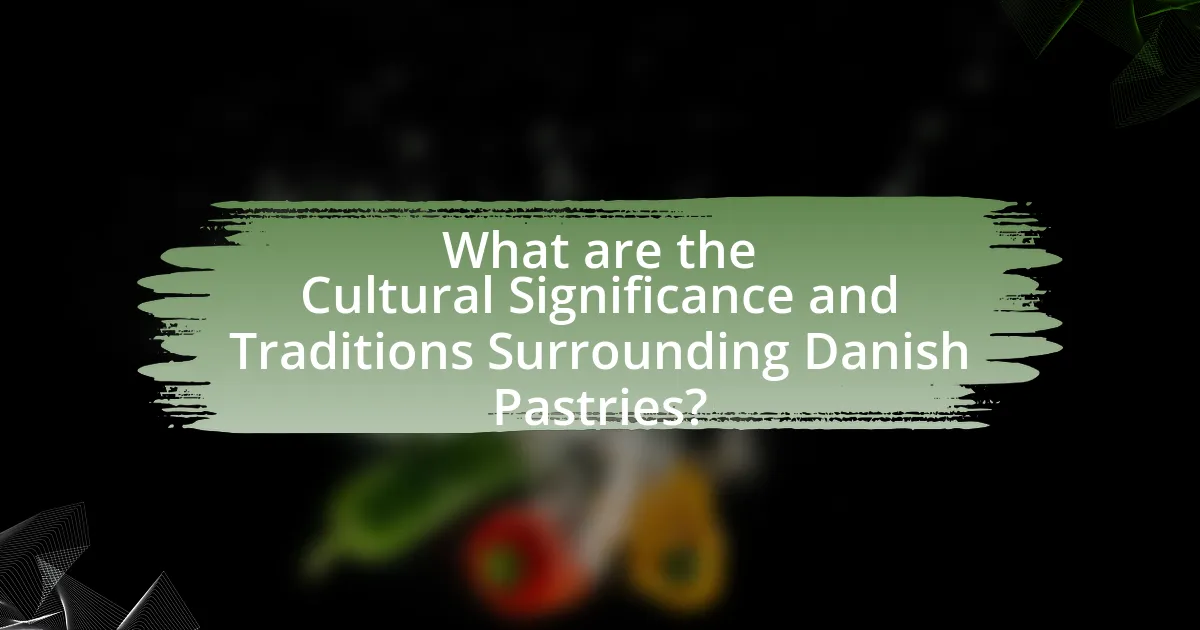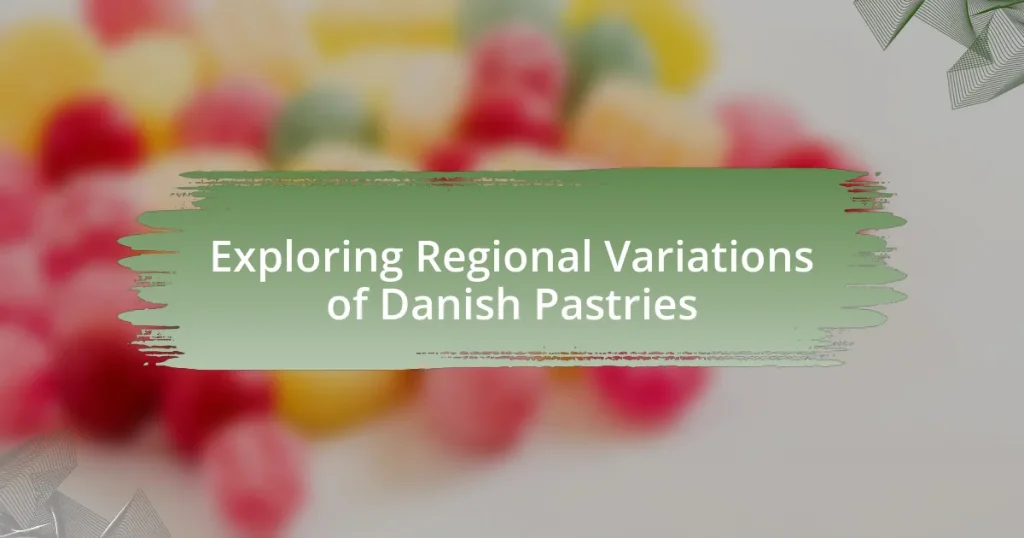Danish pastries are a type of sweet, layered pastry known for their flaky texture and diverse fillings, originating from 19th-century Denmark through the influence of Austrian baking techniques. This article explores the evolution of Danish pastries, highlighting their historical influences, key ingredients, and the role of butter in achieving their signature texture. It also examines regional variations across Denmark and internationally, detailing how local traditions and seasonal ingredients shape the preparation and flavors of these pastries. Additionally, the cultural significance of Danish pastries in celebrations and their adaptations in global culinary contexts are discussed, along with tips for making authentic Danish pastries at home.

What are Danish Pastries and Their Origins?
Danish pastries are a type of sweet, layered pastry known for their flaky texture and variety of fillings, such as fruit, cream cheese, or almond paste. The origins of Danish pastries can be traced back to the 19th century in Denmark, where bakers were influenced by Austrian techniques of laminated dough. This method was introduced to Denmark when Austrian bakers came to the country during a labor strike in 1850. The combination of local ingredients and these new techniques led to the creation of what is now recognized as Danish pastry, which has since evolved into various regional variations around the world.
How did Danish Pastries evolve over time?
Danish pastries evolved from a blend of influences, primarily stemming from the introduction of Viennese baking techniques to Denmark in the 19th century. The arrival of Austrian bakers in the 1850s brought laminated dough methods, which allowed for the creation of flaky, layered pastries. This innovation led to the development of the Danish pastry as it is known today, characterized by its rich, buttery texture and various fillings. Over time, regional variations emerged, incorporating local ingredients and flavors, which further diversified the pastry’s appeal across different cultures.
What historical influences shaped the development of Danish Pastries?
Danish pastries were shaped by a combination of influences from Austrian baking traditions and the introduction of laminated dough techniques in the 19th century. The arrival of Austrian bakers in Denmark during the 1850s brought new pastry-making methods, particularly the use of yeast-leavened dough layered with butter, which is essential for creating the flaky texture characteristic of Danish pastries. This technique was further refined in Denmark, leading to the development of various regional variations that incorporate local ingredients and flavors, such as fruit and cream cheese. The fusion of these influences established Danish pastries as a distinct category in the world of baked goods.
How did the introduction of puff pastry impact Danish Pastries?
The introduction of puff pastry significantly enhanced the texture and flavor profile of Danish pastries. Puff pastry, known for its flaky layers created through a process of lamination, allowed Danish pastries to achieve a light and airy consistency that was previously unattainable with traditional doughs. This innovation not only improved the overall eating experience but also expanded the variety of fillings and toppings that could be used, leading to a broader range of regional variations in Danish pastries. The combination of puff pastry with sweet or savory fillings became a hallmark of Danish pastry, contributing to its popularity and evolution in culinary traditions.
What are the key ingredients in Danish Pastries?
The key ingredients in Danish pastries include flour, butter, milk, sugar, yeast, and eggs. These components are essential for creating the flaky, layered texture characteristic of Danish pastries. The use of butter is particularly important, as it contributes to the rich flavor and the pastry’s signature lamination process, where layers of dough and butter are folded and rolled to achieve a light and airy structure.
How do different ingredients affect the texture and flavor of Danish Pastries?
Different ingredients significantly influence the texture and flavor of Danish pastries. For instance, the use of butter creates a rich, flaky texture due to its high-fat content, which contributes to the layers in the pastry. In contrast, margarine, while cheaper, can result in a denser texture and less flavor complexity. Additionally, the type of flour used affects the gluten development; all-purpose flour yields a tender pastry, while bread flour can create a chewier texture.
Moreover, the inclusion of ingredients like cream cheese or almond paste enhances the flavor profile, adding creaminess or nuttiness, respectively. Sweeteners such as sugar or honey not only provide sweetness but also impact browning during baking, affecting both flavor and appearance. The use of eggs in the dough contributes to a richer flavor and a more tender crumb.
These ingredient variations are supported by culinary studies that show how fat content, flour type, and additional flavorings directly correlate with the sensory qualities of baked goods, including Danish pastries.
What role does butter play in the making of Danish Pastries?
Butter is essential in the making of Danish pastries as it contributes to the pastry’s flaky texture and rich flavor. The lamination process, which involves folding layers of butter into the dough, creates the characteristic light and airy structure of Danish pastries. This technique, which is similar to that used in croissant-making, relies on the butter’s ability to create steam during baking, resulting in distinct layers. The use of high-fat butter enhances the overall taste and mouthfeel, making the pastries more indulgent.

What are the Regional Variations of Danish Pastries?
Danish pastries exhibit regional variations that reflect local tastes and traditions. In Denmark, the classic “wienerbrød” is characterized by its flaky layers and is often filled with custard, fruit, or almond paste. In contrast, in the United States, Danish pastries may incorporate cream cheese fillings and are often topped with icing, showcasing a sweeter profile. Additionally, in Sweden, a variant known as “kanelbullar” features cinnamon and sugar, highlighting the influence of local baking customs. These variations illustrate how Danish pastries have adapted to different culinary cultures while maintaining their core characteristics.
How do Danish Pastries differ across various regions in Denmark?
Danish pastries vary significantly across regions in Denmark, reflecting local ingredients and traditions. In Copenhagen, for instance, pastries often feature rich fillings like marzipan and custard, while in Jutland, they may incorporate local fruits such as apples or berries. Additionally, the shape and preparation methods can differ; for example, the “spandauer” is more prevalent in the capital, characterized by its square shape and cream cheese filling, whereas the “kringle,” a twisted pastry, is more common in the southern regions. These regional distinctions are rooted in historical baking practices and the availability of local produce, showcasing Denmark’s diverse culinary heritage.
What unique ingredients are used in regional variations of Danish Pastries?
Regional variations of Danish pastries utilize unique ingredients that reflect local tastes and traditions. For instance, in Denmark, the classic pastry often incorporates almond paste, while in Sweden, cardamom is a common addition, enhancing the flavor profile. In Norway, a variation known as “kringle” may include fillings like custard or fruit preserves, showcasing regional preferences. Additionally, in the United States, Danish pastries may feature cream cheese or chocolate, adapting to local dessert trends. These ingredient choices highlight the cultural influences and culinary creativity present in different regions.
How do local traditions influence the preparation of Danish Pastries?
Local traditions significantly influence the preparation of Danish pastries by dictating ingredient choices, flavor profiles, and baking techniques. For instance, in regions like Copenhagen, bakers often incorporate local fruits such as rhubarb or berries, reflecting seasonal availability and regional tastes. Additionally, traditional methods, such as the use of laminated dough, are preserved and adapted in various local bakeries, ensuring that each area maintains its unique twist on the classic pastry. Historical practices, such as the influence of German and Austrian baking techniques, have also shaped local variations, leading to distinct styles like the “wienerbrød” that are prevalent in Denmark.
What are some popular types of Danish Pastries in different regions?
Popular types of Danish pastries vary by region, with notable examples including the “Spandauer” in Copenhagen, which is a filled pastry often containing custard or fruit, and the “Kanelstang” in Jutland, a cinnamon-flavored pastry shaped like a stick. In Funen, the “Æbleskiver,” traditionally served during Christmas, are spherical pancakes often filled with apple slices. Each of these pastries reflects local ingredients and baking traditions, showcasing the diversity of Danish pastry culture across different areas.
What distinguishes a Copenhagen pastry from one in Aarhus?
Copenhagen pastries are typically characterized by their intricate designs and a wider variety of fillings compared to those found in Aarhus. In Copenhagen, pastries often feature layers of flaky dough and are filled with ingredients like almond paste, custard, or fruit, reflecting the city’s emphasis on artisanal baking techniques. In contrast, Aarhus pastries tend to be simpler, focusing on traditional flavors and less elaborate presentations, which aligns with the city’s more straightforward culinary approach. This distinction highlights the regional preferences and baking styles that influence the pastry culture in Denmark.
How do seasonal ingredients affect the types of Danish Pastries made in different regions?
Seasonal ingredients significantly influence the types of Danish pastries made in different regions by dictating the flavors and textures available for use. For instance, in spring, regions may incorporate fresh fruits like rhubarb and strawberries, leading to pastries that highlight these seasonal flavors, such as rhubarb tarts or strawberry-filled Danishes. In contrast, winter months often see the use of spices and preserved ingredients, resulting in pastries that feature flavors like cinnamon and cardamom, common in holiday treats. This regional adaptation not only reflects local agricultural cycles but also cultural preferences, as seen in the use of local berries in the summer or nuts in the fall, showcasing how seasonal availability shapes the diversity of Danish pastries across various areas.

What are the Cultural Significance and Traditions Surrounding Danish Pastries?
Danish pastries hold significant cultural importance in Denmark, symbolizing national identity and culinary heritage. Traditionally, these pastries are enjoyed during festive occasions such as Christmas and birthdays, reflecting the Danish custom of gathering for celebrations. The intricate preparation methods, which include laminating dough with butter to create flaky layers, showcase the craftsmanship passed down through generations. Furthermore, Danish pastries are often served with coffee, emphasizing the social aspect of enjoying food together, a practice deeply rooted in Danish culture. The global popularity of Danish pastries has also led to variations in other countries, yet the authentic Danish version remains a point of pride for Denmark, reinforcing its cultural significance.
Why are Danish Pastries important in Danish culture?
Danish pastries are important in Danish culture because they represent a significant culinary tradition and national identity. Originating in the 19th century, these pastries were influenced by Austrian baking techniques, which were adapted by Danish bakers to create unique variations. The pastries are often enjoyed during celebrations and holidays, symbolizing hospitality and community. Their prominence is reflected in Denmark’s annual “Danish Pastry Day,” celebrated on June 24, which highlights their cultural significance and the craftsmanship involved in their preparation.
What role do Danish Pastries play in celebrations and holidays?
Danish pastries serve as a significant element in celebrations and holidays, particularly in Denmark and other countries influenced by Danish culture. These pastries are often featured in festive gatherings, such as Christmas and birthdays, where they symbolize indulgence and celebration. For instance, during the Christmas season, Danish pastries like “kringle” are traditionally enjoyed, reflecting the festive spirit and culinary heritage. Additionally, their intricate designs and variety of fillings make them a popular choice for special occasions, reinforcing their role as a treat that enhances the celebratory atmosphere.
How are Danish Pastries perceived in modern Danish society?
Danish pastries are perceived as a cherished cultural staple in modern Danish society, symbolizing both tradition and culinary artistry. They are commonly enjoyed during social gatherings, celebrations, and as everyday treats, reflecting their integral role in Danish lifestyle. The popularity of Danish pastries is supported by their presence in numerous bakeries across Denmark, where they are often made using high-quality ingredients and traditional techniques, showcasing the country’s commitment to culinary excellence. Additionally, the global recognition of Danish pastries has reinforced their status, with many tourists seeking authentic experiences that include tasting these pastries, further embedding them in the national identity.
How do Danish Pastries fit into the global culinary landscape?
Danish pastries are a significant element in the global culinary landscape, known for their flaky texture and diverse fillings. Originating from Denmark, these pastries have been embraced worldwide, influencing various baking traditions and inspiring local adaptations. For instance, in the United States, Danish pastries are often filled with cream cheese or fruit, showcasing regional tastes while maintaining their characteristic buttery layers. The global popularity of Danish pastries is evidenced by their presence in bakeries across continents, highlighting their versatility and appeal in different culinary contexts.
What adaptations have occurred in Danish Pastries outside of Denmark?
Danish pastries have undergone various adaptations outside of Denmark, particularly in the United States and other countries. In the U.S., for example, the pastries are often filled with cream cheese, fruit, or chocolate, diverging from the traditional almond or custard fillings commonly found in Denmark. Additionally, the dough is frequently made with a higher fat content, resulting in a richer texture. These adaptations reflect local tastes and preferences, leading to a broader range of flavors and styles that differ from the original Danish recipes.
How do international bakeries interpret traditional Danish Pastries?
International bakeries interpret traditional Danish pastries by incorporating local flavors and techniques while maintaining the core elements of the pastry. For instance, bakeries in the United States often add ingredients like cream cheese or fruit fillings, diverging from the classic almond paste or custard typically found in Denmark. This adaptation reflects regional tastes and preferences, allowing the pastries to appeal to a broader audience. Additionally, some international bakeries may alter the shape or presentation of Danish pastries, such as creating larger, more visually striking versions, which cater to local market trends. These variations demonstrate how traditional recipes can evolve while still honoring their origins.
What are some tips for making authentic Danish Pastries at home?
To make authentic Danish pastries at home, focus on using high-quality ingredients, particularly butter, which should be cold and unsalted for optimal flakiness. The dough must be laminated properly, involving multiple folds and turns to create layers; this technique is essential for achieving the characteristic texture of Danish pastries. Additionally, allowing the dough to rest in the refrigerator between folds enhances the development of gluten and improves the final product’s structure.
Proof of these methods can be found in traditional Danish baking practices, where the use of cold butter and precise lamination techniques are emphasized to achieve the desired flaky and tender pastry.
What common mistakes should be avoided when making Danish Pastries?
Common mistakes to avoid when making Danish pastries include not using cold ingredients, which can lead to poor lamination and texture. Additionally, failing to allow adequate resting time for the dough can result in tough pastries, as gluten needs time to relax. Overworking the dough is another mistake, as it can create a dense final product instead of the desired flaky layers. Lastly, neglecting to properly preheat the oven can affect the rise and browning of the pastries, leading to uneven baking. These mistakes can significantly impact the quality and authenticity of Danish pastries.
How can one achieve the perfect flaky texture in homemade Danish Pastries?
To achieve the perfect flaky texture in homemade Danish pastries, one must use a laminated dough technique that incorporates layers of butter and dough. This method involves rolling and folding the dough multiple times to create thin layers, which, when baked, puff up and create a flaky texture. The key is to keep the butter cold and to work quickly to prevent it from melting into the dough, as this ensures distinct layers remain intact during baking. Additionally, using high-quality flour with a higher protein content can enhance the structure and flakiness of the pastry.




